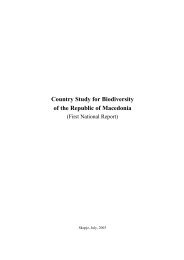CBD Fourth National Report - Azerbaijan (English version)
CBD Fourth National Report - Azerbaijan (English version)
CBD Fourth National Report - Azerbaijan (English version)
You also want an ePaper? Increase the reach of your titles
YUMPU automatically turns print PDFs into web optimized ePapers that Google loves.
Country Study on Biodiversity and <strong>Fourth</strong> <strong>National</strong> <strong>Report</strong><br />
The Republic of <strong>Azerbaijan</strong><br />
erosion process that 40.5% are weakly, 41.85% medium salted and 17.8% strongly eroded<br />
soil.<br />
87.6 thousand ha of eroded lands are located in Mountainous Shirvan, 78.8 thousand ha in<br />
Kalbajar-Lachin and 72.9 thousand ha in Ganja-Gazakh regions.<br />
The above can be referred to land reserves of Nakhichevan AR, too.<br />
However it should be noted that arable lands reached to 50.5 thousand ha from 36.3 thousand<br />
ha or increased as 14.2 thousand ha in 2008 as compared to 2003. It was possible mainly<br />
resulted from involvement of uncropped and pasture fields to farming turnover being more<br />
efficient from economical standpoint.<br />
(See: Annexes 2.1, 2.2, 2.3 and 2.4)<br />
Extent of human impact upon environment<br />
One of factors considerably effecting to aggravation of<br />
Picture<br />
countrywide ecological situation is characterized in<br />
previously accumulated and presently generated wastes<br />
that a part of them is considered to be hazardous.<br />
According to official statistic data, there remained<br />
approximate 2.5 million tons of hazardous wastes<br />
currently which generated in landfills, enterprises and<br />
refuse dumps.<br />
Key industrial output - production of crude oil totalled to 44.5 million tons in 2008. So, the<br />
decline in oil production was prevented which continued yearly due to objective causes since<br />
1990 years. Of course, this growth considerably enhanced the extent of environmental impact.<br />
Volume of pollutants (pollutant dispersion) diverted to water reservoirs decreased as 1.6<br />
times, volume of pollutant emissions as 1.9 times in 2008 in comparison with 2002. Untreated<br />
discharged effluents diverted to water facilities totalled to 181 million m 3 in 2008 and 94% of<br />
incoming sewage are household-sanitary waste waters. Volume of pollutant emissions totalled<br />
to 923 thousand tons and 281 thousand tons out of them are shared by stationary pollution<br />
sources/ fixed sources of environmental pollution.<br />
Volume of waters incoming from countrywide water-storage basins totalled to 11.7 billion<br />
m 3 in 2008, nevertheless this figure equalled to 10 billion m 3 in 2001. Actual consumption of<br />
water was 7.9 billion m 3 , 68% hereof was used in irrigation, 26% in production and 5% for<br />
household-farming purposes. Despite strong water demand appeared in the country, 33% of<br />
intake water is lost while its delivery.<br />
Basic indices characterizing effect of human activity upon the environment are mentioned in<br />
the following table:<br />
Water taken from<br />
water sources,<br />
million m 3<br />
Water consumption,<br />
million m 3<br />
2001 2002 2003 2004 2005 2006 2007 2008<br />
10012<br />
10075<br />
10772<br />
21<br />
11440<br />
12050<br />
12360<br />
12270<br />
11735<br />
6414 6754 7370 8019 8607 8865 8371 7886<br />
2009

















